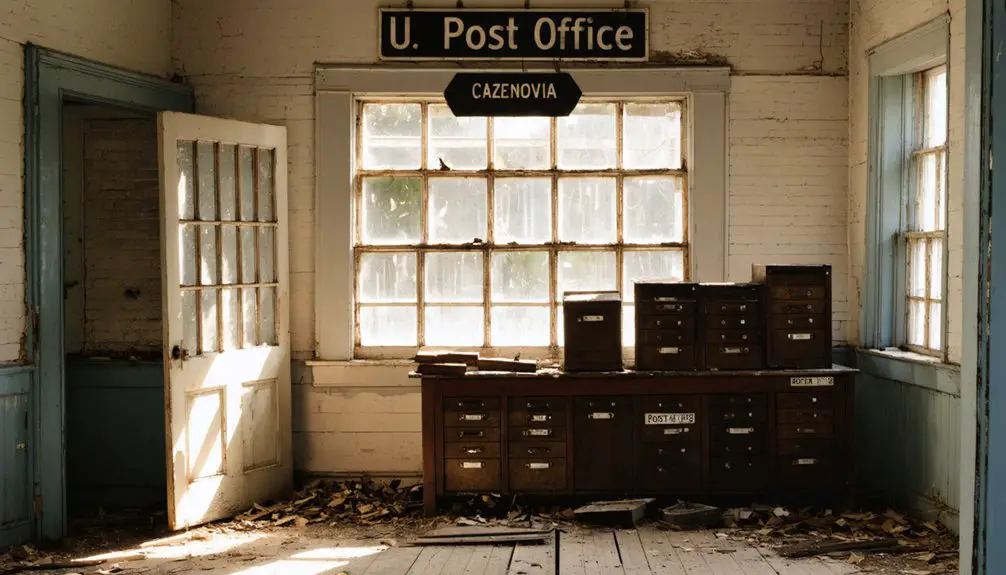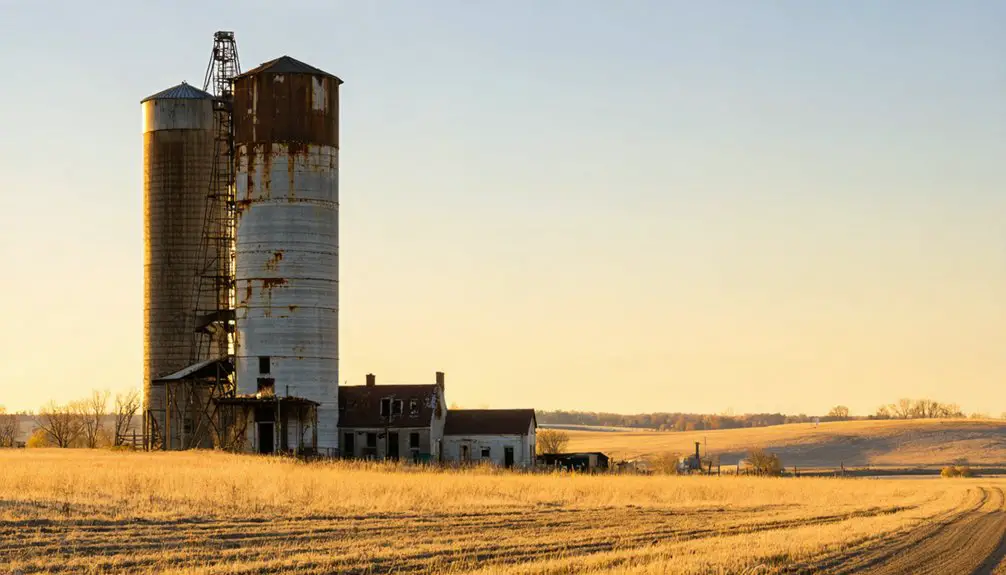You’ll find Cazenovia’s ghost town roots in its 1884 founding by pioneers from Madison County, New York. The town flourished around the Chicago, Rock Island and Pacific Railway station, with a post office opening in 1885. Through the early 1900s, residents relied on the railroad for shipping goods and receiving supplies. After severe flooding in 1935 and declining rail traffic, Cazenovia’s fate was sealed by 1938’s post office closure. The town’s abandoned remnants tell a deeper story of Minnesota’s railroad era.
Key Takeaways
- Founded in 1884 by pioneers from Madison County, New York, Cazenovia thrived initially as a railway town with essential infrastructure.
- The town’s prosperity centered around the Chicago, Rock Island and Pacific Railway station until mid-20th century decline.
- Closure of the post office in 1938 marked a significant milestone in Cazenovia’s transformation into a ghost town.
- Severe flooding in 1935 and increased truck competition led to the railroad’s abandonment in 1937.
- The town’s decline accelerated as younger residents migrated to urban areas, leaving behind an aging population.
The Pioneer Settlement Journey
When pioneers from Madison County, New York established Cazenovia, Minnesota in 1884, they brought with them not just their hopes for a new life but also a cherished name from their original home.
You’ll find their settlement challenges reflected the broader pioneer experience of the era, as they broke new ground, built cabins, and carved out farmland from the Minnesota territory.
Despite the hardships, their community resilience shone through as they quickly established crucial infrastructure, similar to how John Lincklaen founded the original Cazenovia settlement nearly a century earlier.
By 1885, you could visit their newly opened post office, and the Chicago, Rock Island and Pacific Railway station brought economic opportunities.
The settlers, including Yankees, Germans, and Scandinavians, worked together to create essential institutions, forming land companies, schools, and churches that would bind their fledgling community together. Like many other settlements of its time, the town required careful disambiguation efforts to distinguish it from its namesake locations.
Railroad Influence and Early Growth
The arrival of the Chicago, Rock Island and Pacific Railway transformed Cazenovia from a modest pioneer settlement into a bustling transportation hub in the late 1800s. The railroad expansion brought unprecedented opportunities, enabling local farmers to ship their agricultural products to distant markets while reducing transportation costs. Similar to other successful railways like the Minnesota Central Railroad, which operated 66 miles of track, Cazenovia’s line proved essential for regional commerce.
You’d find the station bustling with activity as trains delivered supplies and carried passengers to and from regional centers.
The economic transformation was remarkable. Local businesses flourished around the rail depot, creating jobs in railroad maintenance, operations, and supporting trades. The reliable freight service attracted more settlers, particularly those from Madison County, New York, who saw potential in the well-connected agricultural town. Similar to the five-mile stretch completed between La Valle and Cazenovia in Wisconsin, the railroad here played a vital role in regional development.
Rail service transformed Cazenovia into an economic powerhouse, drawing settlers and entrepreneurs to this vibrant transportation hub.
You’ll notice how Cazenovia’s peak years directly aligned with the railroad’s active period, until the mid-20th century decline in rail transport began affecting the town’s liveliness.
Life in Early Cazenovia
You’ll find the bustling railroad station was Cazenovia’s lifeline, where locals gathered to ship agricultural goods and receive essential supplies from distant markets.
Pioneer life centered around basic survival tasks, with residents splitting time between farming, visiting the local stores, and utilizing the blacksmith’s services. Like the early French fur traders who first explored Minnesota’s wilderness, the townspeople relied heavily on trade to sustain their community.
The community fostered social connections through shared work activities and trade interactions at Wenker’s two-story business building, which served as an informal gathering spot by 1877. The town’s first settlers could purchase essentials at the Lincoln brothers’ store, established as the earliest merchant business in the area.
Railroad Station Activities
Located at a significant junction of the Chicago, Rock Island and Pacific Railway network, Cazenovia’s railroad station served as the town’s primary transportation and social hub from its establishment through the early 20th century.
In 1894, the original train shed was replaced with a new 1½-story depot featuring a distinctive gable roof. Following the architectural trends of the era, the building showcased Stick-Eastlake style design elements. Railroad schedules accommodated both passenger and freight operations, connecting residents to regional trade routes. The depot was equipped with modern amenities including a ticket office, telegraph station, baggage room, and passenger waiting area.
You’d find the station bustling with activity as locals gathered to collect mail, ship agricultural products, or await visiting relatives.
The depot’s freight operations were essential for farmers and merchants, who relied on the railway to export their goods and receive manufactured products.
The station’s integration of postal services made it indispensable for communication in this pre-digital era.
Daily Pioneer Life
While early settlers ventured into Cazenovia’s untamed prairie lands, they faced the immediate challenge of establishing basic shelter and sustenance. You’d find these pioneers first building small 10×14 foot shanties, gradually expanding them as they broke the tough prairie sod for farming.
Your daily pioneer chores would’ve revolved around seasonal work – spring planting, summer crop tending, and fall harvesting.
When the devastating grasshopper plague hit in 1879, you’d need to find alternative work, perhaps clerking at the local store. Community cooperation proved crucial, with neighbors helping each other during peak farming seasons.
You’d rely on the blacksmith to maintain your tools, visit the store for supplies, and trek to the post office to maintain essential connections with the outside world.
Community Social Events
Despite Cazenovia’s modest size, social gatherings formed the heartbeat of pioneer life, with the railway station and post office serving as natural community hubs.
You’d find residents coming together for essential community gatherings like barn raisings and harvest celebrations, where they’d share resources and strengthen social bonds. Like many settlements that struggled during the Panic of 1857, these community events became even more crucial for mutual support and survival. Much like the general store in Forestville, these gatherings provided opportunities for residents to exchange goods and services.
The train’s regular arrivals brought opportunities for cultural celebrations, news exchange, and impromptu market fairs.
Throughout the agricultural year, you’d witness seasonal festivals marking planting and harvest times, while informal events like spelling bees and reading clubs promoted education and literacy.
The post office, operating from 1885 to 1938, became a daily meeting point where you could catch up with neighbors while collecting mail and sharing local news.
Post Office Legacy: 1885-1938

For fifty-three years, Cazenovia’s post office served as an essential communication hub connecting the rural Minnesota settlement to the outside world.
From its establishment in 1885, just one year after the town’s founding, the postal service impact extended far beyond simple mail delivery. You’d find residents gathering to send letters, receive packages, and conduct business transactions that kept their community thriving.
The post office’s strategic location near the Chicago, Rock Island and Pacific Railway station strengthened Cazenovia’s role in regional commerce and communication.
When the facility closed its doors in 1938, it marked more than the end of postal operations – it signaled the beginning of the town’s decline.
Today, the post office’s Doane postmark remains a tangible reminder of Cazenovia’s vibrant past.
The Path to Abandonment
You’ll find Cazenovia’s decline closely tied to the Chicago, Rock Island and Pacific Railway’s diminishing importance, which initially supported the town’s growth but later contributed to its downfall as rail transport gave way to automobiles.
The town’s population steadily decreased through the early 1900s as younger residents moved to larger urban areas offering better economic opportunities, while the aging population remained behind.
Railroad Decline Impact
While many small railroads faced economic challenges in the early 20th century, the Cazenovia Southern Railroad’s decline followed a particularly swift path after severe flooding in July 1935.
The railroad economics of short lines were especially precarious, as they operated with limited freight revenue and geographic reach. You’ll find that increasing freight competition from trucks, combined with expanding highway infrastructure, had already weakened the CSRR’s position before the flood struck.
When multiple bridges washed out along the 5-mile route, the catastrophic repair costs proved insurmountable for the small carrier.
Rather than attempt costly rebuilding, the railroad opted for complete abandonment in 1937. The former rail corridor would later become Wisconsin Route 58, marking the end of this crucial transportation link.
Population Exodus Timeline
The story of Cazenovia’s population decline mirrors its railroad’s fate, beginning with its hopeful establishment in 1884 by settlers from Madison County, New York.
You’ll find distinct population trends throughout the town’s history, starting with steady growth in its early years driven by railway commerce and farming.
Migration patterns shifted dramatically in the 1930s when the Great Depression hit and agricultural practices changed.
The post office’s closure in 1938 marked a turning point, and you can trace the exodus that followed through the 1940s-1960s as younger residents left for better opportunities elsewhere.
Geographic Features and Location

Situated in southwestern Minnesota’s Troy Township, Cazenovia occupies a slice of Pipestone County at 44°04′01″N latitude and 96°22′04″W longitude.
You’ll find this ghost town perched at 1,673 feet above sea level, where the geographic characteristics perfectly match the region’s signature flat-to-rolling plains landscape.
The area’s agricultural suitability stems from its rich soil composition, which has historically supported farming operations across the surrounding countryside.
Native prairie grasses and cultivated crops dominate the terrain, reflecting the land’s natural predisposition for agriculture.
While you won’t find any notable lakes nearby, the site’s position along the former Chicago, Rock Island and Pacific Railway line played a significant role in its development.
Today, you can access what remains of Cazenovia through rural township roads.
Historical Significance in Minnesota’s Development
Founded in 1884 by settlers from Madison County, New York, Cazenovia emerged as a significant pioneer settlement during Minnesota’s territorial expansion.
You’ll find that this town played a crucial role in shaping regional settlement patterns through its strategic position on the Chicago, Rock Island and Pacific Railway.
- You can trace the town’s cultural influences through its diverse architectural styles, from Greek Revival to Gothic.
- You’ll discover how the post office, established in 1885, became the heartbeat of local commerce.
- You’re witnessing history in the Gothic Cottage from 1847, representing early community investment.
- You’ll understand how rail transportation transformed this frontier outpost into a regional hub.
- You’re exploring a reflection of pioneer spirit and determination in Minnesota’s development.
The town’s evolution and eventual decline mirror the broader story of rural Minnesota’s transformation throughout the 20th century.
Frequently Asked Questions
Are There Any Remaining Structures or Ruins Visible at the Site Today?
You won’t find any remaining structures or visible ruins at the site today, as natural reclamation and decay have erased physical traces, leaving the land to return to its natural state.
Did Any Notable Historical Events or Figures Originate From Cazenovia?
You won’t find any notable figures in Cazenovia’s history books. Like many frontier settlements, the town simply served as a modest railway stop before declining, leaving no celebrated historical personalities or events.
What Happened to the Original Residents When the Town Was Abandoned?
You’ll find the residents’ relocation stories led them to nearby towns and cities seeking jobs, while their community memories lived on as families gradually dispersed throughout Minnesota and beyond.
Were There Any Schools or Churches Established During the Town’s Existence?
You won’t find any school history or church legacy here – historical records don’t show evidence of either. Residents likely relied on nearby towns for education and worship services.
How Did the Great Depression Specifically Impact Cazenovia’s Decline?
You’ll find economic hardship devastated local farms during the Depression, causing widespread foreclosures and population decline. By 1938, most families had abandoned their homes, leading to the post office’s closure.
References
- https://www.youtube.com/watch?v=Tp1sKG_5yZc
- https://www.mprnews.org/episode/2023/01/23/a-minnesota-ghost-town-or-a-town-that-never-was
- https://en.wikipedia.org/wiki/Cazenovia
- https://en.wikipedia.org/wiki/List_of_ghost_towns_in_Minnesota
- http://wikimapia.org/13645031/Cazenovia-Minnesota-Ghost-Town
- https://villageofcazenovia.com/about-cazenovia/
- https://storage.googleapis.com/mnhs-org-support/mn_history_articles/14/v14i02p127-171.pdf
- http://genealogytrails.com/minn/pipestone/bios_d.html
- http://www.usgenweb.info/wirichland/books/chap33.htm
- https://www.abandonedrails.com/cazenovia-southern-railroad



